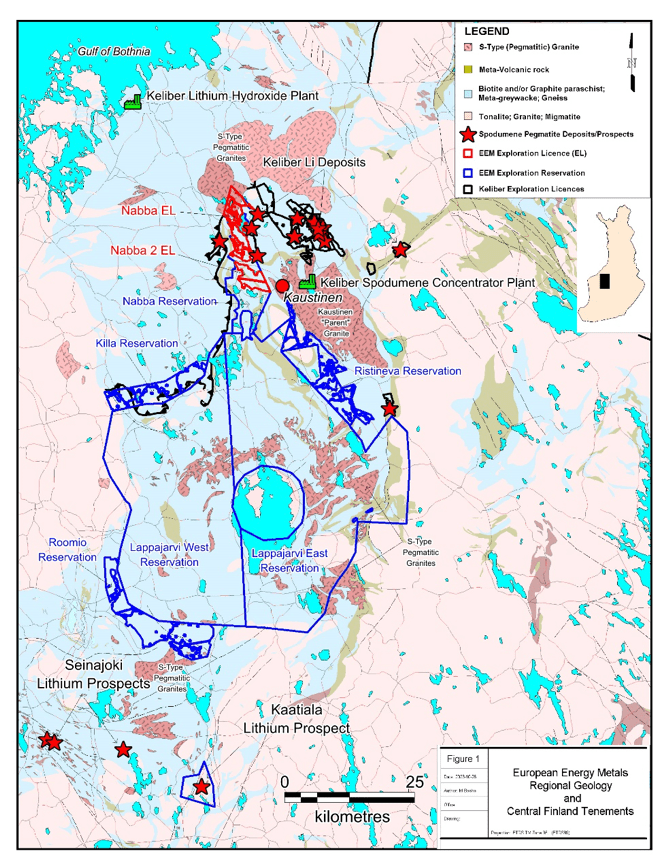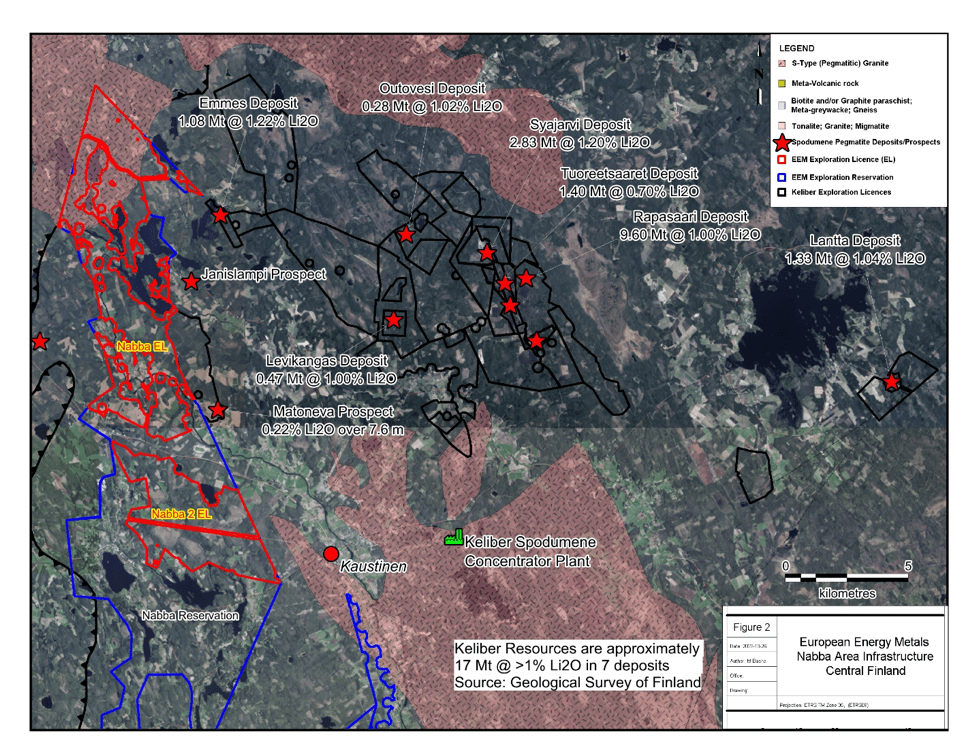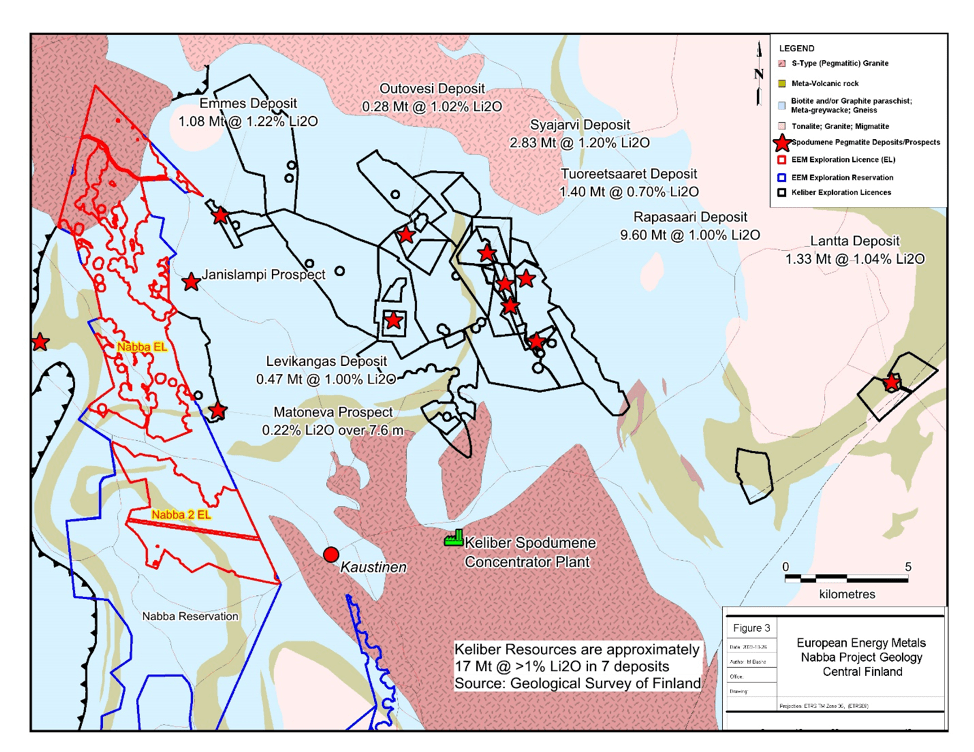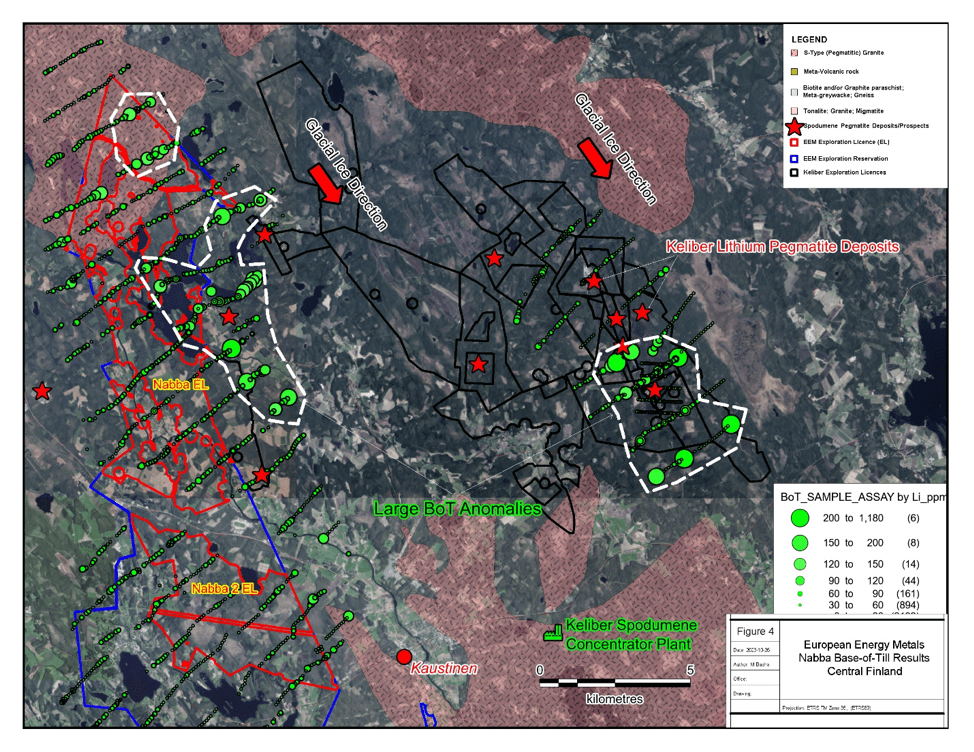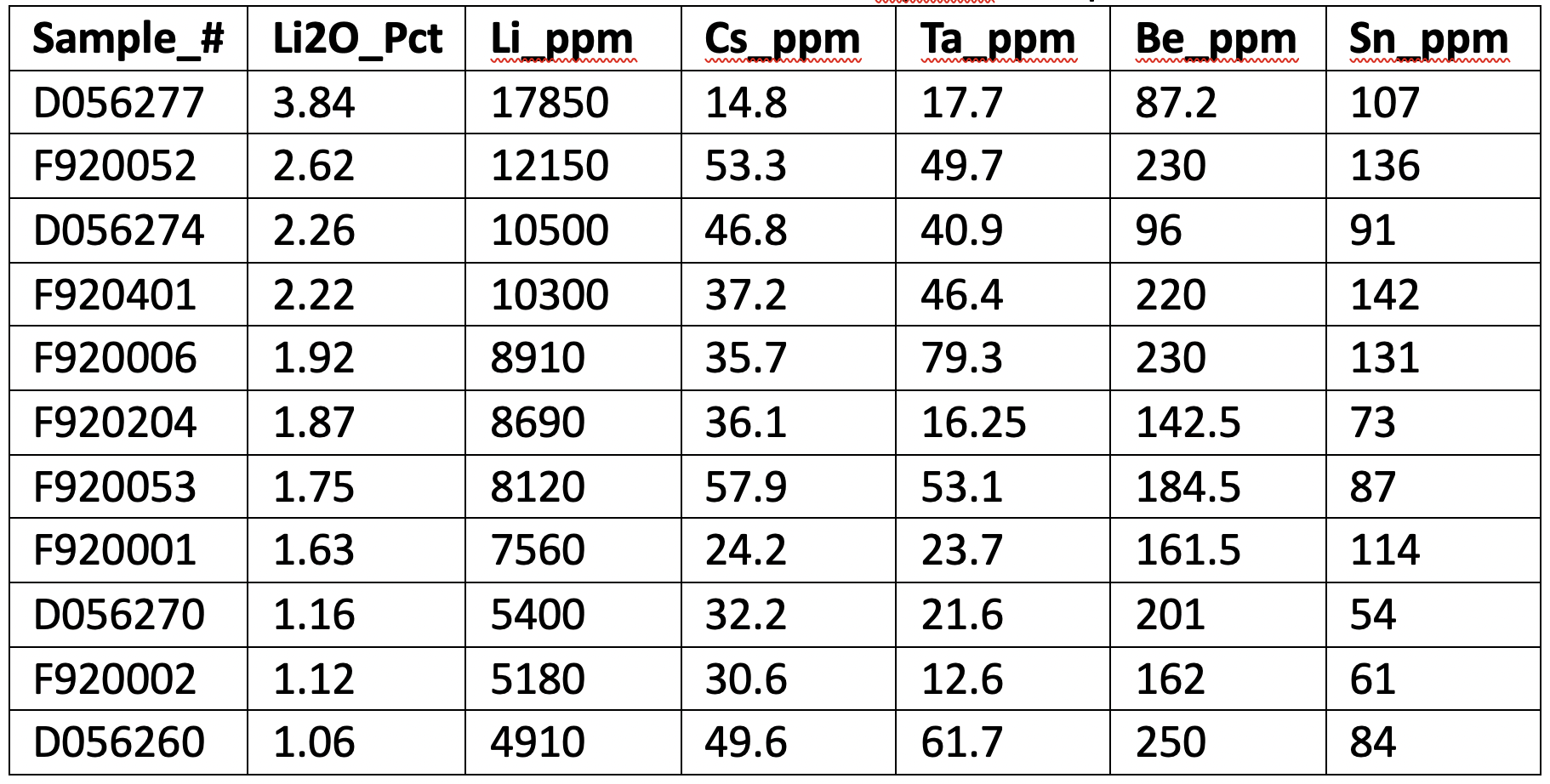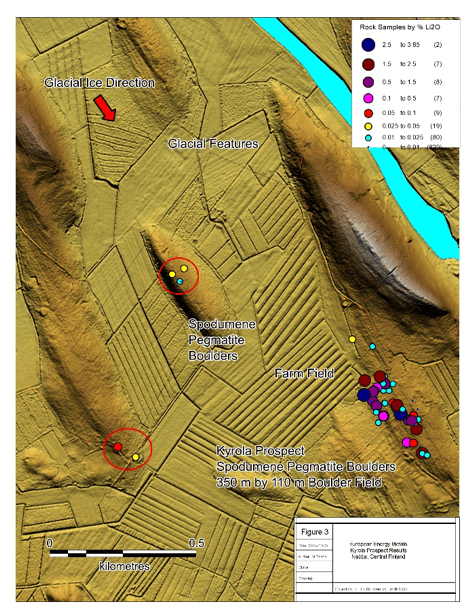The Kaustinen tract is host to several spodumene pegmatite deposits including Sibanye-Stillwaters Keliber Oys deposits which host approximately 12 million tonnes grading >1% Li2O (Source: Keliber Lithium Project, Finland Technical Report Summary Prepared for Sibayne Stillwater Limited by SRK Consulting (South Africa) (Pty) Ltd. dated 2023-Dec-13 with an effective date of 2022-Dec-31. Note this is the source for all subsequent resource or reserve estimates on the remainder of this web page.)
The entire Mines-Mill-Chemical Plant complex is an estimated €600 million investment by Keliber’s parent company Sibanye-Stillwater in partnership with the Finnish Minerals Group, a state-owned entity. When completed this will be a complete hard-rock lithium supply chain (Sibanye-Stillwater website).
The company’s flagship Nabba Project is in the Kaustinen tract.
The flagship Nabba Project covers 11,600 hectares (ha) located just 15 km west of Keliber’s Lithium pegmatite deposit cluster and less than 8 km west of Keliber’s spodumene concentrator mill and 25 south-east of Keliber’s Lithium Hydroxide Chemical Plant in Kokkola on the Gulf of Bothnia coast.
The Keliber story began with the discovery of a spodumene bearing pegmatite boulder in 1959. Through subsequent prospecting and Base of Till (BoT) sampling followed by diamond drilling, primarily by the Geological Survey of Finland, several discoveries were made in the Kaustinen region. Almost all the deposits within the Keliber cluster are blind discoveries and lie under a thin veneer of glacial till.
The Keliber deposits typically have a small footprint and generally comprise multiple parallel spodumene-bearing pegmatite dykes ranging from 1 to 30 m wide and < 500 m long.
Keliber has published a P&P mineral reserve of 8.2Mt at 0.95% Li2O and a M&I mineral resource of 3.8Mt at 1.08% Li2O hosted in several individual lithium-bearing spodumene pegmatite deposits. The nearest deposit to the Nabba Project is the Emmes deposit located approximately 1 km to the east-southeast.
Nabba is underlain by lower amphibolite metamorphic grade sedimentary and lesser mafic volcanic rocks intruded by a ca. 1.8-billion-year-old, S-Type granite in the north. Several grab samples of the granite assayed between 50 to 134 ppm Lithium indicating the granite is potentially fertile and capable of producing Lithium-Cesium-Tantalum (LCT) type pegmatites.
Several Li-spodumene pegmatite prospects/deposits occur within 1 km of Nabba including the Keliber Oy Emmes Deposit consisting of NNW-SSE trending spodumene pegmatites comprising 0.9 Mt grading 1.29% Li2O.
A total of 3,409 widely spaced, historical Base-of-Till (BoT) samples were collected on the Nabba Licence. The company has Lithium analyses for 2063 of the samples. The assay results outlined a large Li-in-till anomaly down-ice (Southeast) of the Nabba licence with individual BoT values up to 200 parts per million (ppm) Li. The regional glacial ice-direction is from the northwest to the southeast implying that the source of this Li-in-till anomalie may lie within the Nabba licence. Note in the BoT anomaly at Keliber lies immediately down-ice of the lithium spodumene pegmatite deposits.
Several prospective areas (i.e. Kyrola, Kaitnabba, Pisto and Kaatiala) with anomalous to locally ore-grade Lithium were identified during the company’s 2023 inaugural exploration program. The best results were obtained on the Nabba Reservation where several clusters of spodumene-bearing pegmatite boulders and boulder fields were identified during the program. A total of 1,099 rock chip (grab) samples were collected across the company’s >250,000-hectare project. The results are discussed in more detail below.
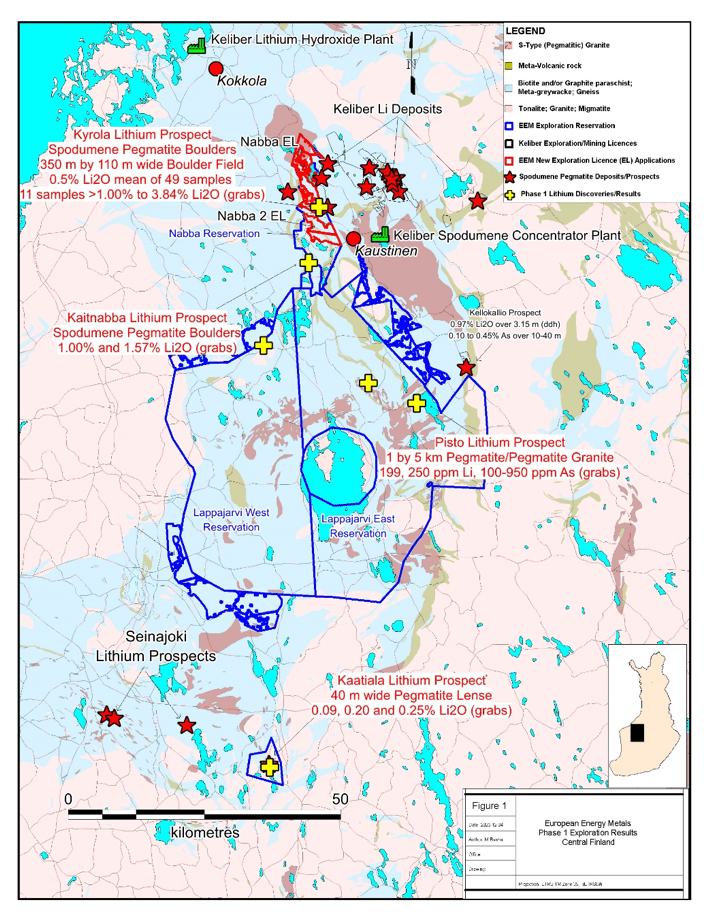
The most significant discovery during the Phase 1 program was the discovery of a 350 m long by 110 m wide Northwest-Southeast trending spodumene-bearing pegmatite boulder field on the Nabba Reservation. The extent of the boulder field is constrained only by low-lying overburden covered areas and farm fields. A total of forty-nine (49) rock chip grab samples were collected from the field and individual samples assayed from 0.003% to 3.84% Li2O. The mean assay of these samples was 0.53% Li2O. Fifteen samples assayed greater than 0.50% Li2O, eleven assayed greater than 1.00% Li2O, 4 assayed greater than 2.00% Li2O and 1 assayed greater than 3.00% Li2O. The boulders are generally angular and range in size from small hand size cobbles up to > 1.5 m in diameter. The boulders are also weakly anomalous in Cesium (Cs), Tantalum (Ta), Beryllium (Ta) and Tin (Sn).
Table 1: Best results from Kyrola Prospect
The boulders are mineralogically comprised of albite-spodumene-quartz-muscovite pegmatite with lesser accessory minerals such as tourmaline, garnet and beryl. They are typically massive to weakly zoned. They appear to be mineralogically similar to the known Keliber deposits in the region, and as such may be part of the same mineralizing event.
Based on the known glacial history of the area and glacial dispersion of pegmatite boulders at the Keliber deposits (Ahtola et al, 2015), it is interpreted that the source of the boulders is likely to be to the northwest of the boulder field, and possibly within 300-500 m. Further studies will be required to confirm and define targets for drilling.
Another cluster of spodumene bearing pegmatite boulders were discovered approximately 9 km southwest of the Kyrola prospect, and also occurring on the Nabba Reservation. Two boulders assayed 1.57% and 1.01% Li2O respectively. The boulders range in size from 0.2 to 0.4 m diameter and are also mineralogically similar to the Keliber deposits. They are also anomalous in Cs, Ta, Be and Sn.
Table 2: Best results from Kaitnabba Prospect
Located on the company’s Lappajarvi East Reservation this prospect consists of an outcropping megacrystic two-mica granite and qtz-feldspar-muscovite-tourmaline pegmatite swarm. Rock chip sampling over an area of several km identified anomalous Li in the 100’s of ppm, up to 250 ppm Li. Many of the samples are also anomalous in Arsenic (As). The presence of As associated with Li is also noted at Keliber’s Kellokallio Prospect approximately 11 km East-Northeast of Pisto where spodumene-bearing pegmatite dyke(s) associated with wide zones of highly anomalous As (eg. 10-40 m assaying 1000 to 4500 ppm As). The best reported Lithium intercept was 0.97% Li2O over 3.15 m. In this context the possibility of using As as a pathfinder element for Li in the area will be considered. Gold occurrences in the region are also often associated with As.
Located 100 km south of Nabba, the 3,200 ha property is host to a 40 m wide quartz-feldspar-muscovite-tourmaline (+/- spodumene) pegmatite body that was mined from 1942 to 1968 for quartz and feldspar. Rock chip sampling of the waste piles around the old mine revealed the presence of Li. The highest Li values obtained were 0.09%, 0.20% and 0.25% Li2O.
Table 3: Best results from Kaatiala Prospect
The company’s Central Finland Lithium projects are in the Kaustinen-Seinajoki region which is highly prospective for LCT pegmatite deposits, as evidenced by the success of the Geological Survey of Finland (GTK) and subsequently Keliber Oy in discovering significant Li-rich spodumene pegmatite prospects and deposits in the region.
The initial success in identifying Lithium-rich pegmatitic boulders from the Phase 1 program is very encouraging, as the area is topographically flat and almost completely covered by a thin veneer of glacial overburden.
On the basis of these results the Company has recently submitted applications for Exploration Licenses (“EL’s”) covering an area of 4,550 hectares within it’s 11,690 hectare (ha) Nabba Reservation, including the area around the Kyrola Prospect. The Nabba EL (2,812 ha) and Nabba 2 EL (1,738 ha) are located on the northern half of the Company’s Nabba Reservation and adjacent to the Keliber Projects of Sibanye-Stillwater (NYSE:SBSW). Under an Exploration License or EL, the Company would be permitted to undertake more advanced exploration such as detailed base-of-till (BoT) sampling, trenching and diamond drilling.
The lithium mineralization on the Keliber project is not necessarily indicative of similar mineralization on the Company's lithium reservations.
Grab samples by their nature are select samples and not necessarily indicative of lithium mineralization on the property.
Information Sources:
Keliber Lithium Project, Finland Technical Report Summary Prepared for Sibayne Stillwater Limited by SRK Consulting (South Africa) (Pty) Ltd. dated 2023-Dec-13 with an effective date of 2022-Dec-31.


